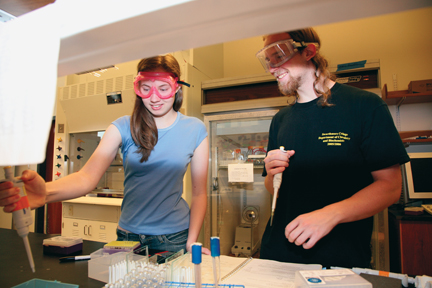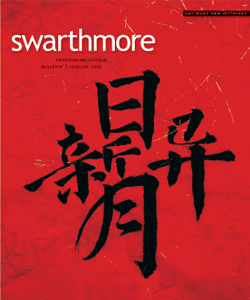Dropping Out—and Dropping In
Three science and engineering retention strategies for women
1. FIXING THE “LEAKY PIPELINE”
Ruth Haas ’82

Statistics show that the number of women choosing careers in science and engineering has grown steadily since 1972, when Title IX of the Civil Rights Act was passed. However, in some areas of science—particularly the physical sciences and engineering—they are a long way from achieving parity with men. Three alumnae have been studying why women leave science and engineering majors and how to make it easier for them to stay.
If you read very much literature about women in science, you will soon encounter the metaphor of the “leaky pipeline.” At every key career transition—from high school to college, college to grad school, grad school to junior faculty, and junior to senior faculty—women seem to drop out in greater numbers than men. But the pipeline imagery fails to reflect the possibility that students can drop into science as well as drop out.
“If you think about your typical image of a math nerd, you see a guy who has known that he’s into math since he was a teenager,” says Ruth Haas, professor of mathematics and statistics at Smith College. “I was like that. Our grad school model is based on that. But there are plenty of people who are good at math who aren’t like that. This seems to be especially true of women, who don’t settle down to doing math until it’s pretty late.”
Haas has started a unique postbaccalaureate program at Smith that is designed to replace one of the so-called “leaks” with an intake valve. The program accepts seven women per year who want to attend graduate school in a mathematical science but don’t have a strong enough background. They are the drop-ins.
“Some of them had prior lives, or they may have been math education majors or math majors who weren’t very serious,” says Haas. One student was a theater major; another was a lawyer. Five of the first year’s seven students are now in mathematics graduate school. “If we can get five more American women into graduate school, that’s a huge accomplishment,” Haas says.
That claim may seem like an exaggeration, but it’s not. On the surface, mathematics appears to be doing better than physics or engineering at attracting women. In 2007, 32 percent of the math Ph.D.s awarded went to women, an all-time high. But the figure is skewed by the presence of foreign students. American women represented only 12.5 percent of the 145 doctorates granted that year.
As a mathematics professor at a single-sex college, Haas has a different perspective on the academic environment for women. “People who come and give talks here feel how unusual it is,” she says. Even women mathematicians are not accustomed to talking to a roomful of female students who are excited and knowledgeable about math.
Some of Haas’s other initiatives are aimed at bringing the Smith experience to more students. The department now has a program that brings women math students from other colleges to Smith for a semester or for their entire junior year. “They find out that there are plenty of women who are serious about math and good at it,” says Haas. “Our women go on in math at a much higher rate than women at co-ed schools.”
This fall, Haas also organized the first Women in Mathematics in New England (WiMiN) conference, intended primarily for undergraduates. “It was amazing,” she says. “We had more than 100 people; we had not anticipated nearly that number. I think the best thing that happened was the networking. Undergraduates had the chance to talk with graduate students and faculty. That was a very popular thing with the undergrads—they like to see people at various levels who look like them. The more you can hear about how people manage their lives through their career paths, the better.”
2. FINDING SUPPORT
Donna Crystal Llewellyn ’80
When Donna Crystal Llewellyn was an undergraduate, she found moral support from an unlikely source. As the only female math major in her class, she didn’t have a student peer group. (One fellow student—the author of this article—gave her an especially hard time. “You were mean!” she says today.) The faculty, though very supportive, were all male. “What saved the environment for me was Joyce, the department secretary,” she says. “She watched out for me, because she knew I was the only woman. Also, the librarians were my support group.”
Of course, her experience in honors wasn’t all bad. “Those seminars, even with the jibes and the teasing, were the best preparation for graduate school,” she says. “The main thing is that it was fair. The message was never sent that you shouldn’t be competing because you’re a woman, or that you don’t belong here.” At the first graduate school she attended, she feels that the faculty projected a very different attitude: Women did not belong.
Llewellyn is now the director for the Center for the Enhancement of Teaching and Learning (CETL) at Georgia Tech, a position she took after several years as a professor of operations research. At CETL, she works with faculty on their teaching skills, and she sees first-hand the problems that women face during their junior faculty years.
“It’s very intense for women, in that they have a higher default advising load,” Llewellyn says. “Students tend to seek them out more for experience and advice—just as I did with the women librarians at Swarthmore. If a man is too busy to advise students, he is seen as productive. But students will give lower ratings to a woman who is too busy.”
“Then there’s the issue of the biological clock and the tenure clock, which overlap for most women,” Llewellyn continues. On that issue, there has been progress at Georgia Tech since she arrived. “We have procedures to stop the tenure clock, and we have leave options. When I got here, there was only sick leave and no maternity leave. Now there is a better attitude on campus, and some men even take paternity leave.”
On a national level, Llewellyn founded (and named) an interest group called Women in Operations Research and Management Science (WORMS), within the national society for operations research (INFORMS). Its membership has taken off over the last 10 years. “Back then, there were only a handful of women. Now we fill a ballroom at the annual meeting,” she says. Clearly, her days of being the only woman are over.
3. LEARNING HOW TO STUDY
Lynne Molter ’79
For Professor of Engineering Lynne Molter, who got her engineering degree at Swarthmore and has now taught at the College for 21 years, one incident crystallized her interest in student retention. It happened more than 10 years ago.
“One of my students came into my office and said that she was going to transfer out of engineering,” Molter says. “She told me that she was working so hard that she wasn’t able to get enough sleep, and yet her grades were mediocre.”
“I asked her, ‘Tell me how you study for an exam.’ She said, ‘I read the book.’ Then I just happened to ask her, ‘How many times?’ And she said ‘Seven times.’” Molter’s jaw dropped.“‘What about the examples?’ I asked. She said, ‘Oh no, I skipped them.’”
After that, Molter started asking other first-year students how they studied. And it turned out that many others were studying in a way that was inappropriate for an engineering course. In engineering, working examples and studying concepts (rather than re-reading the textbook or memorizing facts) is the most effective way to learn. “They didn’t know how to approach the material, and it was breaking my heart,” says Molter. Juniors and seniors didn’t seem to have the same problems—but was it because the way they were studying was optimal, or had the system simply driven out the students who didn’t study in that way?
Molter may soon find out some answers. Together with K. Ann Renninger of the Department of Educational Studies, she is collecting information from students, at the time they declare their majors, about their goals and the choices they have made. They are also surveying engineering majors retrospectively about the same questions.
Molter and Renninger are also collaborating with Robert Koff of Washington University at St. Louis, on a project in which they are collecting and coordinating retention data at several highly selective colleges and universities. “We’re up to our elbows in data—tens of thousands of student records,” she says. Both of these projects are funded by the Alfred P. Sloan Foundation. Although neither project focuses exclusively on women, they are likely to reveal some of the ways in which female students’ choices or learning styles affect retention.
Meanwhile, Molter and her colleagues in the department of engineering have worked to improve their support system for all students. For instance, the department has a full-time staff position held by an alumna of the department, Ann Tran Ruether ’94, to provide individualized help for each student for whom it could be useful, especially those in their first year. Reuther proactively monitors students’ progress in all of their math, science, and engineering courses, through collaboration and cooperation with faculty in those departments, and runs a help program five evenings a week.
 Email This Page
Email This Page